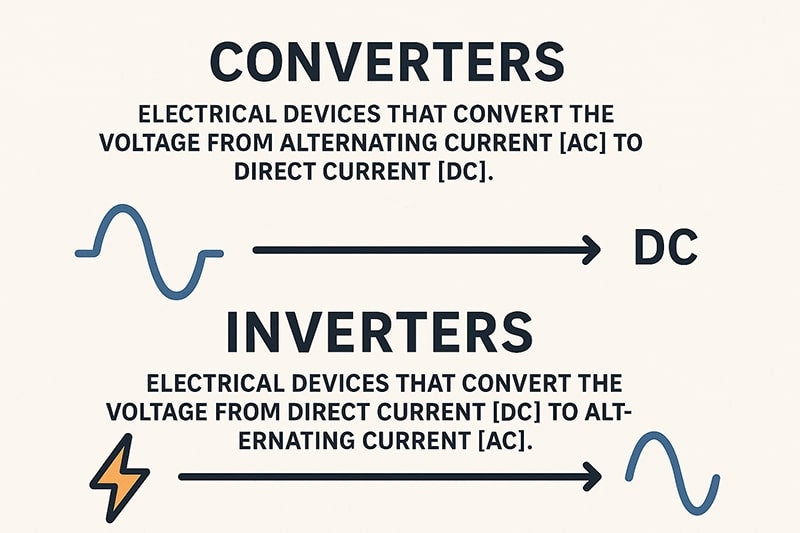Understanding the difference between an inverter and a converter is fundamental for anyone working with modern power systems — from RV owners and solar installers to people choosing a UPS or off-grid setup. Though the terms are sometimes used interchangeably in casual conversation, they perform distinct roles in electrical systems.
AC vs DC — the core idea
AC (Alternating Current) changes direction periodically and is the standard for household mains power. DC (Direct Current) flows in one direction and is what batteries and many electronic devices use. Converters and inverters move power between these forms (and between voltage levels) depending on the needs of the system.
What is a Converter?
A converter typically changes voltage level or converts AC to DC (or DC to a different DC voltage). Common converter types include:
- AC → DC converter (rectifier) — converts mains AC to DC to charge batteries or power DC-only circuits.
- DC → DC converter — changes one DC voltage to another (for example, 48V → 12V).
Typical use cases: charging 12V battery banks from shore power in an RV, powering DC lighting and control circuits, or creating regulated DC rails for electronics.
What is an Inverter?
An inverter converts DC into AC so that AC-powered appliances (household outlets, motors, power tools) can run from battery sources such as solar storage or a UPS. Inverters are essential in:
- Solar power systems (DC from panels/batteries → AC for the home)
- UPS devices that provide AC backup during outages
- Vehicle or marine installations that need standard AC while off-grid
Side-by-side comparison
| Aspect | Converter | Inverter |
|---|---|---|
| Primary function | Change voltage or convert AC ↔ DC (commonly AC → DC / DC → DC) | Convert DC → AC |
| Typical applications | Battery charging, DC loads, voltage regulation in RVs & electronics | Running household appliances from batteries, solar output, UPS AC backup |
| Also called | Rectifier (AC→DC), DC-DC regulator | Power inverter |
| Key spec to check | Output voltage/current, conversion efficiency, regulation | Continuous & surge power (W), waveform type (pure sine wave vs modified) |
Pure sine wave vs modified sine wave (inverters)
If you’re picking an inverter for sensitive electronics (PCs, audio gear, modern PSU with active PFC), choose a pure sine wave inverter. Modified sine wave inverters can cause noise, inefficiencies, or compatibility problems with some devices.
Real-world examples & use-cases
RVs
In RVs you commonly see both: a converter that converts shore AC to 12V DC to run lights and charge batteries while plugged in, and an inverter that turns the stored DC back into AC when you’re boondocking.
Solar + battery systems
Solar panels output DC. A charge controller and converter/DC-DC components regulate and store energy in batteries. An inverter is then used to provide AC for household loads. For fully integrated solutions, hybrid inverter/charger units combine functions.
UPS & backup power
UPS systems include an inverter (DC battery → AC) and often a charger (AC → DC) to keep the battery topped when mains power is present. When shopping for online/industrial UPS solutions, evaluate continuous output and waveform quality carefully.
How to choose the right device
- Identify the direction of conversion you need: AC→DC (converter/charger), DC→AC (inverter), or both (inverter/charger hybrid).
- Match power specs: Ensure wattage/VA ratings meet continuous and surge requirements of your loads.
- Check waveform: For sensitive electronics, choose pure sine wave inverters.
- Consider integrated solutions: Hybrid inverter-chargers simplify installations for off-grid or backup systems.
- Plan battery capacity separately: Converters and inverters draw from battery banks — sizing batteries is a distinct step.
Further resources & recommended categories
For robust AC backup equipment and enterprise/consumer grade online UPS options, you can explore an extensive catalog of online UPS products — useful when you need continuous clean AC supply for sensitive equipment.
If you’re sizing battery banks for off-grid or extended autonomy, check out off-grid battery bank options and accessories here: off-grid battery bank solutions.
Quick summary
- Converter = voltage conversion and/or AC→DC (charging/regulation)
- Inverter = DC→AC (run AC devices from DC sources)
- Many systems require both — ensure compatibility, correct sizing, and proper waveform for your loads.
Conclusion
While converters and inverters both move electrical energy between forms, they are not interchangeable. Selecting the correct device (or integrated hybrid) depends on whether you need to charge batteries, run DC loads, or power AC appliances from a DC source. Understanding each device’s role prevents mismatches, improves efficiency, and protects your equipment.
